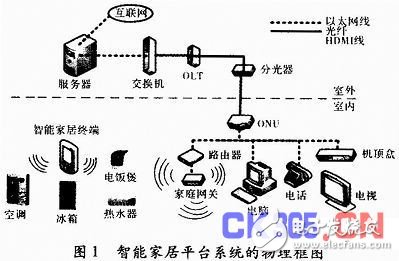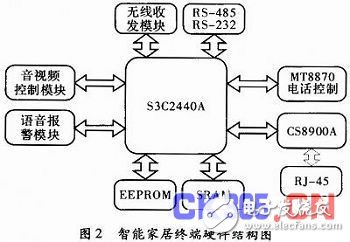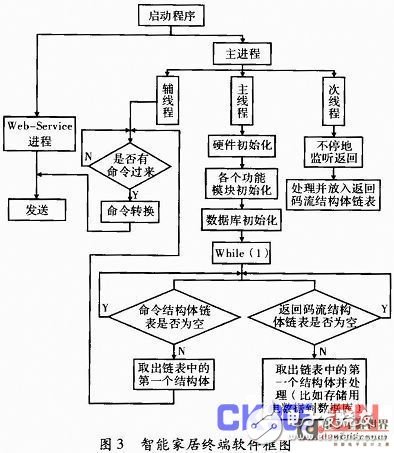The so-called smart grid refers to the future grid that can form a two-way interaction between business flow, information flow and energy flow through new technology, also called “smart gridâ€. Compared with traditional power grids, smart grids have a larger market space. The smart grid is a technology-intensive, capital-intensive assembly that will drive innovation and development of traditional industries such as new energy, information, and sensors. It has strong technical radiation and economic driving. The smart home system is one of the prominent aspects. The core device of the smart home system is the smart home terminal, through which system information collection, information output, centralized control, remote control, linkage control and other functions are realized.
1 Technical characteristics of smart home platform systemSmart home networks continue to evolve with the implementation of integrated technologies, communication technologies, interoperability and cabling standards, involving the application of operational, management and integration technologies for all intelligent and non-smart appliances, devices and systems in the home network. .
(1) The composition of the home intelligent platform system.The home intelligent platform system is established through a smart home gateway, a smart home terminal, a socket with power collection and power functions, and system software. The intelligent home gateway is the core part of the smart home LAN, which mainly completes the conversion and transmission between various communication protocols of the home internal network.
Using computer technology, microelectronics technology, and communication technology, the smart home terminal integrates almost all functions of home intelligence, so that the smart home is built on a unified platform. First, to realize the data exchange of the home internal network, and secondly to ensure that the instructions transmitted through the network are legal, the smart home terminal is not only the transportation hub of family information, but also the protection god of the informationized family.
(2) Interconnection with home appliances through communication modules and communication protocols.In order to realize the control of home appliances and the collection of related information, the system platform transmits and receives the code stream through the serial port through the communication module and according to a specific communication protocol, thereby realizing the control and information collection of the home appliance.
(3) The application of embedded systems in hardware.With the continuous increase of functions and the continuous improvement of performance, higher requirements are placed on processing power and speed, so a high-performance embedded chip system will be applied to smart home terminals.
2 Structure of the smart home platform systemThe physical block diagram of the smart home platform system is shown in Figure 1.

The functions of the smart home terminal include the following aspects:
(1) Home appliance control. Home appliance control is the main function of smart home terminal, which represents the development direction of home intelligence, and controls the household electrical equipment through wireless communication.
(2) Collection and analysis of electricity consumption information. Collect some electricity consumption data such as electricity consumption, power, voltage and current of the household appliance, and display it in the form of a table or a chart, and analyze the household electricity consumption for the user, thereby guiding the user to use the electricity reasonably.
(3) Family security. Safety is the primary requirement of residents for smart homes, so home security has become an important part of smart homes. Including home security alarms, door and window magnetic alarms, gas leak alarms, fire smoke alarms, emergency help alarms, etc. When the smart home terminal is in the armed state, once the infrared probe detects that someone in the house is walking, it will automatically alarm and report the alarm information to the property management center. The alarm information can also be sent to the owner's mobile phone or other mobile terminal.
(4) Video call. The video intercom function is integrated on the smart home terminal to realize the video call function between the terminals.
(5) Convenience information service. The property management center is connected with the smart home terminal to release some community information and some convenience service information around the community to the residents, thus providing convenience for the residents.
(6) Value-added services. Through the smart home terminal, online shopping, video on demand and other value-added services can be realized.
4 hardware design of smart home terminalThe smart home terminal's microprocessor uses the S3C2440A, a 16/32-bit RISC microprocessor from Samsung that provides a low-cost, low-power, high-performance small-scale microcontroller solution for handheld devices and general-purpose applications. . The S3C2440A uses the ARM920t core, 0.13μm CMOS standard macrocells and memory cells. It uses the AMBA bus architecture. The ARM920t implements MMU, AMBA BUS and Harvard cache architectures. This structure has a separate 16 kB instruction cache and 16 kB data cache.
As the control center of smart home, the smart home terminal should provide audio and video interface, alarm sensor interface, HUB interface and RS-232 interface in addition to network RJ-45 interface, PSTN interface, RS-485 interface and wireless transmission module interface. Wait. These interfaces can implement audio and video codec conversion, command transmission and reception, and integration with a PC.
The hardware implementation structure of the smart home terminal is shown in Figure 2.

In the telephone control part, when the user presses the control button on the remote phone keypad, the information is sent through the telephone line in a dual audio manner, and the MT8870 is a dual-tone multi-frequency decoding chip capable of implementing dual tone multi-frequency signals (DTMF). Send and receive.
The Ethernet control chip uses the CS8900A, a low-power, high-performance 16-bit Ethernet controller from Cirrus Logic. The chip's outstanding features are flexible, its physical layer interface, data transfer mode and working mode can be dynamically adjusted according to needs, through the internal register settings to adapt to different application environments.
In addition, the hardware part has been extended to meet the needs of SRAM. In addition, due to some important parameters on the smart home terminal, it needs to be reserved in the case of system power failure, so EEPROM expansion is also performed on the terminal.
5 Software design of smart home terminal 5.1 ProgrammingBased on the hardware structure, the software system uses the Linux embedded operating system, and the kernel version is 2.6.28. In view of the performance of the selected ARM chip, from the overall demand, the software part adopts multi-process + multi-threaded programming scheme in the process. The program is generally divided into two processes: the main process, the Web-Service process. The main process consists of three threads: the main thread, the secondary thread, and the secondary thread.
The Web-Service process sends a command code stream. It should be noted here that the home gateway also adopts the Web-Service method, the smart home terminal acts as a client, and the home gateway acts as a server.
The main control process implements most of the functions and is the main body of the control center. Due to the real-time nature and uncertainty of information recovery, it starts up and is always running. The main thread first initializes when the program starts, including the driver initialization of each part of the hardware, the initialization of each functional module interface and its basic functions, and the initialization of the data storage part database. After the initialization is completed, it will enter a while(1) loop, and iteratively repeats the traversal of the command structure chain list and the return code stream structure chain list, and performs corresponding processing. The secondary thread completes the conversion and processing of the command code stream. The secondary thread listens to the command code stream returned to the terminal and performs corresponding conversion and processing.
The overall block diagram of the software section is shown in Figure 3.

Two processes are designed in the program and communication is required between them. Two parallel processes can cooperate by sending messages to each other, and messages are passed between processes through message buffering. The interprocess communication method uses a named pipe (FIFO), which is a first-in, first-out queue. It is similar to a pipe and only allows one-way flow of data. Each FIFO has a name that allows unrelated processes to access the same FIFO. The program defines named pipes in the /tmp file system so that when the system is restarted or updated, the pipes are cleared and do not take up too much storage space.
In addition, in order to avoid the confusion of access and operation caused by the simultaneous access of the same shared resource between two processes, the process must be locked before the process accesses the shared resource, and the process is released after the access is completed. In the three threads of the main process, in order to ensure that two or more key code segments are not called concurrently, the semaphore is also used in the thread. Before entering a critical code segment, the thread must acquire a semaphore once. The critical code segment is completed, then the thread must release the semaphore, and other threads that want to enter the critical code segment must wait until the first thread releases the semaphore.
6 ConclusionThe smart home terminal and its supporting equipment will be continuously developed and improved to provide people with a safer, more comfortable and convenient living environment. The system will also be more convenient to use, low in price and reliable in performance. This paper presents the design scheme of smart home terminal based on ARM chip, designs a feasible hardware and software model, and solves some design problems of smart home terminal in theory.
Newest Vape,New E-Cigarette,Electronic Cigarette Vaporizer Pen,Custom Vaporizer Pen
Guangzhou Yunge Tianhong Electronic Technology Co., Ltd , https://www.e-cigaretteyfactory.com
